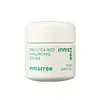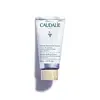What's inside
What's inside
 Key Ingredients
Key Ingredients

 Benefits
Benefits

 Concerns
Concerns

 Ingredients Side-by-side
Ingredients Side-by-side

Water
Skin ConditioningPropanediol
SolventGlycerin
HumectantStearyl Dimethicone
EmollientMethyl Trimethicone
Skin ConditioningPentaerythrityl Tetraethylhexanoate
EmollientButylene Glycol Dicaprylate/Dicaprate
EmollientGlyceryl Polymethacrylate
1,2-Hexanediol
Skin ConditioningPolymethylsilsesquioxane
Squalane
EmollientHydroxyethyl Acrylate/Sodium Acryloyldimethyl Taurate Copolymer
Emulsion StabilisingPolyglyceryl-3 Methylglucose Distearate
EmulsifyingCarbomer
Emulsion StabilisingHydrogenated Lecithin
EmulsifyingCholesterol
EmollientGlyceryl Stearate
EmollientTromethamine
BufferingSodium Stearoyl Glutamate
CleansingLactobacillus Ferment Lysate
Skin ConditioningHyaluronic Acid
HumectantPanthenol
Skin ConditioningAllantoin
Skin ConditioningSodium Metaphosphate
BufferingCamellia Sinensis Seed Oil
HumectantCetearyl Alcohol
EmollientXanthan Gum
EmulsifyingGlyceryl Caprylate
EmollientButylene Glycol
HumectantEthylhexylglycerin
Skin ConditioningSorbitan Isostearate
EmulsifyingSodium Hyaluronate
HumectantCamellia Sinensis Leaf Extract
AntimicrobialMadecassoside
AntioxidantLactic Acid
BufferingDextrin
AbsorbentTheobroma Cacao Extract
Skin ConditioningHydrolyzed Hyaluronic Acid
HumectantSodium Hyaluronate Crosspolymer
HumectantCamellia Sinensis Seed Extract
HumectantCeramide NP
Skin ConditioningTocopherol
AntioxidantPhytosphingosine
Skin ConditioningSodium Acetylated Hyaluronate
HumectantWater, Propanediol, Glycerin, Stearyl Dimethicone, Methyl Trimethicone, Pentaerythrityl Tetraethylhexanoate, Butylene Glycol Dicaprylate/Dicaprate, Glyceryl Polymethacrylate, 1,2-Hexanediol, Polymethylsilsesquioxane, Squalane, Hydroxyethyl Acrylate/Sodium Acryloyldimethyl Taurate Copolymer, Polyglyceryl-3 Methylglucose Distearate, Carbomer, Hydrogenated Lecithin, Cholesterol, Glyceryl Stearate, Tromethamine, Sodium Stearoyl Glutamate, Lactobacillus Ferment Lysate, Hyaluronic Acid, Panthenol, Allantoin, Sodium Metaphosphate, Camellia Sinensis Seed Oil, Cetearyl Alcohol, Xanthan Gum, Glyceryl Caprylate, Butylene Glycol, Ethylhexylglycerin, Sorbitan Isostearate, Sodium Hyaluronate, Camellia Sinensis Leaf Extract, Madecassoside, Lactic Acid, Dextrin, Theobroma Cacao Extract, Hydrolyzed Hyaluronic Acid, Sodium Hyaluronate Crosspolymer, Camellia Sinensis Seed Extract, Ceramide NP, Tocopherol, Phytosphingosine, Sodium Acetylated Hyaluronate
Water
Skin ConditioningHexyldecyl Stearate
EmollientCellulose
AbsorbentHydrogenated Jojoba Oil
AbrasiveGlycerin
HumectantVitis Vinifera Seed Oil
EmollientMel
EmollientC14-22 Alcohols
Emulsion StabilisingPotassium Cetyl Phosphate
EmulsifyingMyristyl Alcohol
EmollientSodium Acrylates Copolymer
Caprylyl Glycol
EmollientParfum
MaskingHydrogenated Polyisobutene
EmollientBenzyl Alcohol
PerfumingC12-20 Alkyl Glucoside
EmulsifyingXanthan Gum
EmulsifyingHelianthus Annuus Seed Oil
EmollientMyristyl Glucoside
CleansingButylene Glycol
HumectantPhospholipids
Skin ConditioningPolyglyceryl-10 Stearate
Skin ConditioningTocopherol
AntioxidantGlycyrrhiza Glabra Root Extract
BleachingDehydroacetic Acid
PreservativeBenzyl Benzoate
AntimicrobialHexyl Cinnamal
PerfumingLimonene
PerfumingLinalool
PerfumingWater, Hexyldecyl Stearate, Cellulose, Hydrogenated Jojoba Oil, Glycerin, Vitis Vinifera Seed Oil, Mel, C14-22 Alcohols, Potassium Cetyl Phosphate, Myristyl Alcohol, Sodium Acrylates Copolymer, Caprylyl Glycol, Parfum, Hydrogenated Polyisobutene, Benzyl Alcohol, C12-20 Alkyl Glucoside, Xanthan Gum, Helianthus Annuus Seed Oil, Myristyl Glucoside, Butylene Glycol, Phospholipids, Polyglyceryl-10 Stearate, Tocopherol, Glycyrrhiza Glabra Root Extract, Dehydroacetic Acid, Benzyl Benzoate, Hexyl Cinnamal, Limonene, Linalool
 Reviews
Reviews

Ingredients Explained
These ingredients are found in both products.
Ingredients higher up in an ingredient list are typically present in a larger amount.
Butylene Glycol (or BG) is used within cosmetic products for a few different reasons:
Overall, Butylene Glycol is a safe and well-rounded ingredient that works well with other ingredients.
Though this ingredient works well with most skin types, some people with sensitive skin may experience a reaction such as allergic rashes, closed comedones, or itchiness.
Learn more about Butylene GlycolGlycerin is already naturally found in your skin. It helps moisturize and protect your skin.
A study from 2016 found glycerin to be more effective as a humectant than AHAs and hyaluronic acid.
As a humectant, it helps the skin stay hydrated by pulling moisture to your skin. The low molecular weight of glycerin allows it to pull moisture into the deeper layers of your skin.
Hydrated skin improves your skin barrier; Your skin barrier helps protect against irritants and bacteria.
Glycerin has also been found to have antimicrobial and antiviral properties. Due to these properties, glycerin is often used in wound and burn treatments.
In cosmetics, glycerin is usually derived from plants such as soybean or palm. However, it can also be sourced from animals, such as tallow or animal fat.
This ingredient is organic, colorless, odorless, and non-toxic.
Glycerin is the name for this ingredient in American English. British English uses Glycerol/Glycerine.
Learn more about GlycerinTocopherol (also known as Vitamin E) is a common antioxidant used to help protect the skin from free-radicals and strengthen the skin barrier. It's also fat soluble - this means our skin is great at absorbing it.
Vitamin E also helps keep your natural skin lipids healthy. Your lipid skin barrier naturally consists of lipids, ceramides, and fatty acids. Vitamin E offers extra protection for your skin’s lipid barrier, keeping your skin healthy and nourished.
Another benefit is a bit of UV protection. Vitamin E helps reduce the damage caused by UVB rays. (It should not replace your sunscreen). Combining it with Vitamin C can decrease sunburned cells and hyperpigmentation after UV exposure.
You might have noticed Vitamin E + C often paired together. This is because it is great at stabilizing Vitamin C. Using the two together helps increase the effectiveness of both ingredients.
There are often claims that Vitamin E can reduce/prevent scarring, but these claims haven't been confirmed by scientific research.
Learn more about TocopherolWater. It's the most common cosmetic ingredient of all. You'll usually see it at the top of ingredient lists, meaning that it makes up the largest part of the product.
So why is it so popular? Water most often acts as a solvent - this means that it helps dissolve other ingredients into the formulation.
You'll also recognize water as that liquid we all need to stay alive. If you see this, drink a glass of water. Stay hydrated!
Learn more about WaterXanthan gum is used as a stabilizer and thickener within cosmetic products. It helps give products a sticky, thick feeling - preventing them from being too runny.
On the technical side of things, xanthan gum is a polysaccharide - a combination consisting of multiple sugar molecules bonded together.
Xanthan gum is a pretty common and great ingredient. It is a natural, non-toxic, non-irritating ingredient that is also commonly used in food products.
Learn more about Xanthan Gum